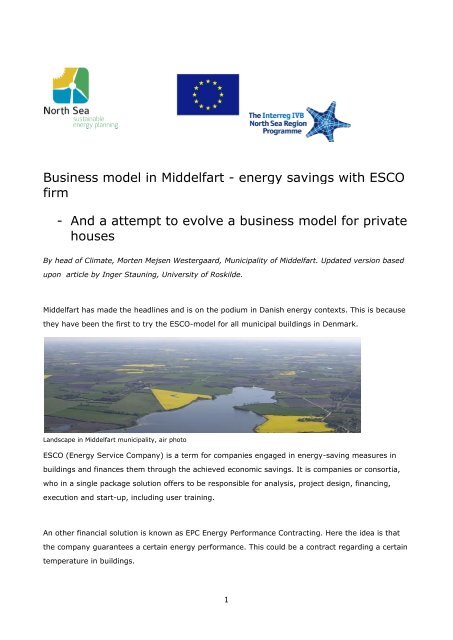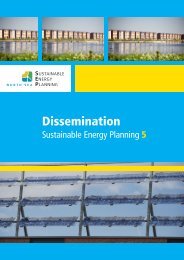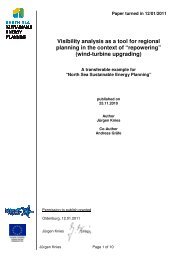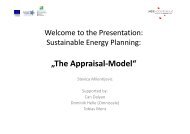Business model in Middelfart - energy savings with ESCO firm - And ...
Business model in Middelfart - energy savings with ESCO firm - And ...
Business model in Middelfart - energy savings with ESCO firm - And ...
You also want an ePaper? Increase the reach of your titles
YUMPU automatically turns print PDFs into web optimized ePapers that Google loves.
<strong>Bus<strong>in</strong>ess</strong> <strong>model</strong> <strong>in</strong> <strong>Middelfart</strong> - <strong>energy</strong> sav<strong>in</strong>gs <strong>with</strong> <strong>ESCO</strong><br />
<strong>firm</strong><br />
- <strong>And</strong> a attempt to evolve a bus<strong>in</strong>ess <strong>model</strong> for private<br />
houses<br />
By head of Climate, Morten Mejsen Westergaard, Municipality of <strong>Middelfart</strong>. Updated version based<br />
upon article by Inger Staun<strong>in</strong>g, University of Roskilde.<br />
<strong>Middelfart</strong> has made the headl<strong>in</strong>es and is on the podium <strong>in</strong> Danish <strong>energy</strong> contexts. This is because<br />
they have been the first to try the <strong>ESCO</strong>-<strong>model</strong> for all municipal build<strong>in</strong>gs <strong>in</strong> Denmark.<br />
Landscape <strong>in</strong> <strong>Middelfart</strong> municipality, air photo<br />
<strong>ESCO</strong> (Energy Service Company) is a term for companies engaged <strong>in</strong> <strong>energy</strong>-sav<strong>in</strong>g measures <strong>in</strong><br />
build<strong>in</strong>gs and f<strong>in</strong>ances them through the achieved economic sav<strong>in</strong>gs. It is companies or consortia,<br />
who <strong>in</strong> a s<strong>in</strong>gle package solution offers to be responsible for analysis, project design, f<strong>in</strong>anc<strong>in</strong>g,<br />
execution and start-up, <strong>in</strong>clud<strong>in</strong>g user tra<strong>in</strong><strong>in</strong>g.<br />
An other f<strong>in</strong>ancial solution is known as EPC Energy Performance Contract<strong>in</strong>g. Here the idea is that<br />
the company guarantees a certa<strong>in</strong> <strong>energy</strong> performance. This could be a contract regard<strong>in</strong>g a certa<strong>in</strong><br />
temperature <strong>in</strong> build<strong>in</strong>gs.<br />
1
Many municipalities and major build<strong>in</strong>g owners are presently consider<strong>in</strong>g whether to enter <strong>in</strong>to<br />
<strong>ESCO</strong> collaborations and which <strong>model</strong>s they should use and are therefore very <strong>in</strong>terested <strong>in</strong><br />
experiences from <strong>Middelfart</strong>. The bus<strong>in</strong>ess <strong>model</strong> <strong>with</strong><strong>in</strong> <strong>ESCO</strong>, does call on customers to consider<br />
an number of questions:<br />
� Can <strong>ESCO</strong>s satisfy expectations when conduct<strong>in</strong>g entire renovation processes to user<br />
satisfaction?<br />
� Is it economically worthwhile for the municipality, are payback times realistic?<br />
� Are the best <strong>energy</strong> solutions achieved, is it a good <strong>model</strong> <strong>in</strong> relation to renovation of<br />
build<strong>in</strong>gs?<br />
� What problems occur <strong>in</strong> relation to be<strong>in</strong>g responsible for the renovation yourself?<br />
� Can the <strong>model</strong> be extended to private homes, <strong>in</strong>stitutions, and hous<strong>in</strong>g associations?<br />
� Could small construction enterprises and other actors use a similar <strong>model</strong> and/or participate<br />
as partners <strong>in</strong> such <strong>model</strong>s?<br />
� Does the <strong>model</strong> ensure enough sav<strong>in</strong>gs – why not be really ambitious?<br />
� What is the amount of build<strong>in</strong>gs and can the amount be enlarged dur<strong>in</strong>g the process?<br />
� Is it possible to conduct further <strong>energy</strong>-sav<strong>in</strong>gs <strong>in</strong> the build<strong>in</strong>gs dur<strong>in</strong>g an <strong>ESCO</strong> process? In<br />
other words, is it possible to improve the performance <strong>with</strong> a new <strong>ESCO</strong> <strong>in</strong> the process ?<br />
<strong>And</strong> how is base-l<strong>in</strong>e managed?<br />
These questions can only be answered on the basis of experience of some years. Here the<br />
“<strong>Middelfart</strong> <strong>model</strong>” is presented and it’s background, some po<strong>in</strong>ts of discussion and further plans for<br />
<strong>energy</strong> development <strong>in</strong> <strong>Middelfart</strong>.<br />
Paper content<br />
� “<strong>Middelfart</strong> <strong>model</strong>” - the background and progress<br />
o Energy renovation almost free of cost ...<br />
o Energy plann<strong>in</strong>g on market terms<br />
o Investment <strong>model</strong><br />
o Operat<strong>in</strong>g period and users<br />
� Advantages and disadvantages for economy and environment?<br />
o Could the municipality conduct the work themselves?<br />
o Role of the <strong>ESCO</strong><br />
o Role of the <strong>energy</strong> supply company<br />
o The low hang<strong>in</strong>g fruits<br />
o Ma<strong>in</strong>tenance and renewable <strong>energy</strong>?<br />
� Partnership on <strong>energy</strong> sav<strong>in</strong>gs <strong>in</strong> homes?<br />
2
o Partnership<br />
o We have an offer for you ...<br />
o Next step <strong>in</strong> the <strong>model</strong> – before the first step is put to ground<br />
o Spatial plann<strong>in</strong>g as a part of a bus<strong>in</strong>ess <strong>model</strong>?<br />
� Low <strong>energy</strong> class 1 as requirements for new build<strong>in</strong>gs<br />
o District heat<strong>in</strong>g vs. low <strong>energy</strong> requirements<br />
o Network, competency development – free-municipality?<br />
The <strong>Middelfart</strong> <strong>model</strong> – background and progress<br />
The merg<strong>in</strong>g of municipalities created a new map, where “small municipalities” foolhardy rashness<br />
was merged <strong>with</strong> the county’s expertise”, as head of climate Morten M. Westergaard and director of<br />
technique and environment Thorbjørn Sørensen puts it. The three municipalities <strong>Middelfart</strong>, Ejby<br />
and Nørre Aaby and had no particular environmental profile, and there had been no systematic<br />
<strong>energy</strong> management on municipal build<strong>in</strong>gs.<br />
The new <strong>Middelfart</strong> municipality was <strong>in</strong>terested <strong>in</strong> creat<strong>in</strong>g growth and development. They saw<br />
opportunities <strong>in</strong> environment and <strong>energy</strong>. A strategy for “<strong>Middelfart</strong> - the green growth<br />
municipality” was adopted by the city council.<br />
In recent years a number of <strong>in</strong>itiatives on environment and climate have been launched:<br />
� Climate Municipality Agreement <strong>with</strong> the Danish Society for Nature Conservation of 2% CO2<br />
reduction per year<br />
� Requirements for low <strong>energy</strong> class 1 <strong>in</strong> local plans compris<strong>in</strong>g larger construction works<br />
� Large nature park project H<strong>in</strong>dsgavl Deer Park and Nature’s Day<br />
� Energy Renovation of all municipal build<strong>in</strong>gs over 10 years <strong>with</strong> <strong>ESCO</strong><br />
� “My climate plan”: a partnership <strong>with</strong> packaged solutions for private <strong>energy</strong> renovation – a<br />
concept that cont<strong>in</strong>uously is elaborated<br />
Energy renovation almost free of cost ...<br />
The director for technique and environment came from Funen County <strong>with</strong> many good ideas, among<br />
others <strong>with</strong> knowledge of the <strong>ESCO</strong>-concept. Some municipalities <strong>in</strong> Sweden had used an <strong>ESCO</strong> for<br />
<strong>energy</strong>-renovation and the <strong>model</strong> was presented to the city council as a <strong>model</strong> where the <strong>energy</strong><br />
sav<strong>in</strong>gs would pay all costs of <strong>energy</strong> renovation. It was a <strong>model</strong> which appealed to the politicians<br />
and a pilot project was launched.<br />
At the same time the local <strong>energy</strong> supply company Trefor was <strong>in</strong>vited to participate. They were<br />
promised that <strong>energy</strong> sav<strong>in</strong>gs <strong>in</strong> municipal build<strong>in</strong>gs could be <strong>in</strong>cluded <strong>in</strong> their statutory annual<br />
<strong>energy</strong> sav<strong>in</strong>gs and therefore made free <strong>energy</strong> consultancy available.<br />
3
In the pilot project a representative sample of 8 municipal build<strong>in</strong>gs (30,000 m2) was reviewed by<br />
consultants from Trefor. They found potential sav<strong>in</strong>gs of 19-24% <strong>with</strong> a simple payback time of 6-<br />
10 years. By comparison <strong>with</strong> the total build<strong>in</strong>g stock (133 190,000 m2) and its <strong>energy</strong><br />
consumption a sav<strong>in</strong>gs potential of approx. 20% at a total <strong>in</strong>vestment of 33-41 million DKK was<br />
made probable. 1)<br />
The project was cut short when it’s cont<strong>in</strong>uation was h<strong>in</strong>dered by the state imposed cap on<br />
construction work. A dispensation was to be approved, which the M<strong>in</strong>ister of Climate and Energy<br />
had promised, but the M<strong>in</strong>ister of F<strong>in</strong>ance would not approve it. F<strong>in</strong>ally it was given by the M<strong>in</strong>ister<br />
of Welfare - as an <strong>in</strong>terest<strong>in</strong>g welfare project, but <strong>with</strong>out a word of it be<strong>in</strong>g an <strong>in</strong>terest<strong>in</strong>g <strong>energy</strong><br />
project.<br />
Energy plann<strong>in</strong>g on market terms<br />
The city council decided on a total fund<strong>in</strong>g of 44 million DKK which would encompass both <strong>energy</strong>-<br />
sav<strong>in</strong>g measures and other wishes for build<strong>in</strong>g modifications. They decided to put the project out for<br />
procurement. There were 5 companies who made bids on the <strong>energy</strong> sav<strong>in</strong>gs they could guarantee.<br />
The w<strong>in</strong>n<strong>in</strong>g bid secured an overall sav<strong>in</strong>g of 20% annually and provided a payback time on <strong>energy</strong><br />
<strong>in</strong>vestment of 10-11 years. After w<strong>in</strong>n<strong>in</strong>g the procurement, the company should prepare the actual<br />
project design <strong>in</strong>clud<strong>in</strong>g what type of <strong>in</strong>itiatives would be implemented <strong>in</strong> which build<strong>in</strong>gs and<br />
calculate the amount of sav<strong>in</strong>gs that could be achieved.<br />
The municipality was assisted by the Swedish municipalities and by consultants <strong>in</strong> design<strong>in</strong>g the<br />
procurement and contracts. Stopp<strong>in</strong>g po<strong>in</strong>ts were deliberately <strong>in</strong>corporated, so the city council could<br />
opt out on several po<strong>in</strong>ts dur<strong>in</strong>g the progress of the project and renew their position towards the<br />
plan.<br />
With this procurement it was up to companies themselves to f<strong>in</strong>d the build<strong>in</strong>g improvements that<br />
would provide the greatest <strong>energy</strong> sav<strong>in</strong>gs. From the beg<strong>in</strong>n<strong>in</strong>g the municipality has thus deselected<br />
to let other requirements for the renovation and <strong>energy</strong> solutions affect the project, for example<br />
experimental solutions, or renovations <strong>with</strong> an emphasis on comfort, aesthetics or build<strong>in</strong>g<br />
improvements.<br />
However, it has been part of the negotiations that other improvements could be added to the<br />
def<strong>in</strong>ed <strong>in</strong>itiatives, which <strong>in</strong> turn would cause a longer payback time. The city council has been able<br />
to determ<strong>in</strong>e how large a sum was to be spent on <strong>energy</strong> improvements <strong>with</strong> guaranteed sav<strong>in</strong>gs<br />
and what additional improvements they wished for to be carried out simultaneously.<br />
Investment <strong>model</strong><br />
On the background of the specific <strong>energy</strong> conservation projects <strong>in</strong> municipal build<strong>in</strong>gs the <strong>ESCO</strong><br />
could develop a comprehensive plan <strong>with</strong> a total guaranteed <strong>energy</strong> sav<strong>in</strong>gs of 20%, shared among<br />
4
concrete <strong>energy</strong> sav<strong>in</strong>gs targets for each build<strong>in</strong>g. For these <strong>in</strong>vestments there could be a payback<br />
time of 10-11 years. In addition to this the municipality had different additional requests to be<br />
<strong>in</strong>cluded. If these additional costs were to be also paid back via <strong>energy</strong> sav<strong>in</strong>gs, the payback period<br />
for the total <strong>in</strong>vestment will be approximately 19 years.<br />
The city council agreed on spend<strong>in</strong>g 44 million DKK on the projects. The municipality has loaned the<br />
money themselves as they can obta<strong>in</strong> cheaper loans, and then made them available to the <strong>ESCO</strong>.<br />
The <strong>ESCO</strong> must <strong>in</strong> turn perform the specified tasks. If the guaranteed 20% sav<strong>in</strong>gs each year<br />
(compared to the situation prior to the project) <strong>in</strong> the first 7 years is not achieved, the <strong>ESCO</strong> must<br />
pay the difference. Additional sav<strong>in</strong>gs up to 3% will accrue to the municipality. Additional sav<strong>in</strong>gs<br />
beyond that are shared between the <strong>ESCO</strong> and the municipality. After the first 7 years all future<br />
sav<strong>in</strong>gs accrue to the municipality.<br />
The city council decided on that basis to launch the project. At the same time they decided that the<br />
possible 3% additional sav<strong>in</strong>gs should go back to the respective <strong>in</strong>stitution to provide an <strong>in</strong>centive<br />
for behavioral change and additional sav<strong>in</strong>gs.<br />
Operational period and users<br />
After projects are completed <strong>in</strong> each <strong>in</strong>stitution <strong>energy</strong> consumption must be registered and<br />
employees are to be tra<strong>in</strong>ed to manage systems and <strong>in</strong>stallations etc., to ensure correct<br />
measurement of sav<strong>in</strong>gs. However, it may become difficult to prove any discrepancy from the<br />
expected sav<strong>in</strong>gs.<br />
Employees and users have received the project favorably. There have been no objections or<br />
additional requests from users. It is already the central adm<strong>in</strong>istration who is <strong>in</strong> charge of build<strong>in</strong>g<br />
ma<strong>in</strong>tenance.<br />
It has given some unrest <strong>in</strong> the city that each school cannot use the craftsmen they are accustomed<br />
to, but it is the <strong>ESCO</strong> that assign contractors and craftsmen to do the work. Problems may also<br />
arise if subsequent <strong>in</strong>vestments <strong>in</strong> further <strong>energy</strong> sav<strong>in</strong>g measures are made and alterations<br />
implemented. To whom will the possible additional sav<strong>in</strong>g accrue?<br />
Advantages and disadvantages for economy and environment?<br />
Could the municipality conduct the work themselves?<br />
<strong>Middelfart</strong> municipality sees, accord<strong>in</strong>g to the director of technique and environment, this project as<br />
a good solution for their renovation needs. They have not themselves been able to perform the<br />
analytical work Trefor has provided and anyhow they would have to sign a contract <strong>with</strong> a company<br />
that could carry out the renovation work. They have also achieved a lot of PR on be<strong>in</strong>g pioneers on<br />
this field.<br />
5
The municipality has not built its own expertise to handle <strong>energy</strong> management and greater <strong>energy</strong><br />
renovation projects. They have not been accustomed to make larger <strong>in</strong>vestments to achieve returns<br />
later, such as private companies would do. It would therefore require considerable time and<br />
resources to achieve the necessary competence and project management.<br />
The municipality has been able to identify the low-hang<strong>in</strong>g fruits but has not had the resources to<br />
pick them themselves. Time will tell whether the project will fulfill expectations or whether the<br />
municipality has paid a high price for the accomplished renovations.<br />
Role of the <strong>ESCO</strong><br />
The <strong>ESCO</strong> perform<strong>in</strong>g the work, is a large mult<strong>in</strong>ational company, Schneider Electric, which has<br />
<strong>energy</strong> services as one of their specialties. They are ga<strong>in</strong><strong>in</strong>g ground <strong>in</strong> Denmark and several other<br />
municipalities are now cooperation <strong>with</strong> them, among others Kalundborg, Kertem<strong>in</strong>de and Gribskov.<br />
There are other possible <strong>model</strong>s for <strong>ESCO</strong>-cooperation; DONG has for example, <strong>in</strong> collaboration <strong>with</strong><br />
the Spar Nord bank, announced that they offer <strong>energy</strong> services as an <strong>ESCO</strong>, and there could also be<br />
local partnerships <strong>with</strong> f<strong>in</strong>anciers, <strong>energy</strong> supply companies and local contractors.<br />
The task for the <strong>ESCO</strong> <strong>in</strong> <strong>Middelfart</strong> is to specify a number of tasks that can provide at least 20%<br />
sav<strong>in</strong>gs and execute them <strong>with</strong><strong>in</strong> the agreed period of time, and to tra<strong>in</strong> users to operate the<br />
equipment. In an agreed period of 7 years they are required to pay the difference if sav<strong>in</strong>gs are less<br />
than 20%, and <strong>in</strong> return they receive half of the profits if they manage to save more than 23%.<br />
Furthermore, they perform a series of tasks which the municipality wishes carried out<br />
simultaneously under normal conditions.<br />
The <strong>ESCO</strong> has the role of turnkey contractor but they outsource sub-tasks to other companies,<br />
among others local craftsmen. The municipality has <strong>in</strong> this case f<strong>in</strong>anced the work themselves<br />
through municipal loans, but the <strong>ESCO</strong> would also have been able to handle the f<strong>in</strong>anc<strong>in</strong>g.<br />
Role of the <strong>energy</strong> supply company<br />
Trefor has provided analytical work for free, both <strong>in</strong> the pilot project and the major project. Their<br />
<strong>in</strong>terest is to record the expected annual sav<strong>in</strong>gs as a part of the sav<strong>in</strong>gs they are required to<br />
provide accord<strong>in</strong>g to an agreement <strong>with</strong> the national government as part of the Energy Agreement<br />
2005. For them it is a question of what it costs to achieve these sav<strong>in</strong>gs, for example <strong>in</strong> comparison<br />
<strong>with</strong> replac<strong>in</strong>g circulation pumps <strong>in</strong> the <strong>in</strong>dustry sector or provid<strong>in</strong>g private <strong>energy</strong> consultancy.<br />
Perhaps a price will be put on these sav<strong>in</strong>gs <strong>in</strong> the future. The municipality might have sold their<br />
sav<strong>in</strong>gs too cheap by giv<strong>in</strong>g them away <strong>in</strong> exchange for analytical work.<br />
Trefor has through the project achieved competence <strong>in</strong> perform<strong>in</strong>g these tasks and will <strong>in</strong> future be<br />
able to develop a bus<strong>in</strong>ess concept as an <strong>ESCO</strong>.<br />
6
The low hang<strong>in</strong>g fruits<br />
There have not been systematic <strong>energy</strong> management <strong>in</strong> the municipality before and because of the<br />
cap on construction work and budget cutbacks there have not been many <strong>in</strong>vestments <strong>in</strong> <strong>energy</strong><br />
improvements for quite some years. Even <strong>with</strong> the promised projects <strong>Middelfart</strong> will probably still<br />
use more <strong>energy</strong> than the most <strong>energy</strong>-conscious municipalities, accord<strong>in</strong>g to the director of<br />
technique and environment.<br />
This means that on the one hand, the <strong>ESCO</strong> <strong>model</strong> cannot be used by everyone, as many other<br />
municipalities have already completed the most profitable projects, and therefore there is little to<br />
achieve for an <strong>ESCO</strong>.<br />
On the other hand, the solutions offered may simply be to pick the low hang<strong>in</strong>g fruits, such as<br />
<strong>energy</strong> sav<strong>in</strong>g light bulbs and replacement of circulation pumps, while the more expensive<br />
solutions, such as replacement of w<strong>in</strong>dows and improved build<strong>in</strong>g envelope will not be conducted.<br />
There will <strong>in</strong> a few years perhaps be a need for a new renovation process <strong>in</strong> order to replace<br />
w<strong>in</strong>dows etc.<br />
Ma<strong>in</strong>tenance and renewable <strong>energy</strong>?<br />
Furthermore, the plans aim at economic sav<strong>in</strong>gs while renewable <strong>energy</strong> or improvements of<br />
build<strong>in</strong>gs and functions are <strong>in</strong> focus. In this <strong>model</strong>, the municipality will not cont<strong>in</strong>ue to build<br />
competence for cont<strong>in</strong>u<strong>in</strong>g <strong>energy</strong> improvements and to <strong>in</strong>tegrate <strong>energy</strong> sav<strong>in</strong>gs <strong>in</strong> ongo<strong>in</strong>g<br />
ma<strong>in</strong>tenance. If the municipality accomplished the project themselves they would perhaps achieve<br />
much greater sav<strong>in</strong>gs and ga<strong>in</strong> competence for future <strong>energy</strong> renovations.<br />
Critics of this scheme argue that the <strong>ESCO</strong> can perform a sub-optimal <strong>energy</strong> plann<strong>in</strong>g, where only<br />
the offhand economically cost-effective sub-projects are implemented. Perhaps the future will see<br />
large supplementary bills for needed renovation. A coherent long term plan for ma<strong>in</strong>tenance,<br />
<strong>energy</strong> sav<strong>in</strong>gs and a focus on renewable <strong>energy</strong> could provide more optimal solutions <strong>in</strong> terms of<br />
both economy and <strong>in</strong> terms of CO2 reductions.<br />
Partnerships on <strong>energy</strong> sav<strong>in</strong>gs <strong>in</strong> homes<br />
Employees at the environment and climate area could see that there are large potential for sav<strong>in</strong>gs<br />
<strong>in</strong> the municipality's hous<strong>in</strong>g stock - gold wait<strong>in</strong>g to be dug out. They could see possibilities <strong>in</strong><br />
transferr<strong>in</strong>g the <strong>ESCO</strong> <strong>model</strong> to private build<strong>in</strong>gs.<br />
Maybe it was possible to get private owners to carry out <strong>energy</strong>-renovation, if they were offered a<br />
package deal where project design, f<strong>in</strong>anc<strong>in</strong>g and implementation were carried out by a company or<br />
partnership.<br />
7
Partnership<br />
<strong>Middelfart</strong> municipality summoned various local actors <strong>in</strong> order to establish a collaboration, among<br />
others:<br />
� <strong>Middelfart</strong> sav<strong>in</strong>gs bank<br />
� Energy supply company Trefor<br />
� The district heat<strong>in</strong>g company<br />
� The local <strong>energy</strong> service<br />
� Rockwool<br />
� Region South<br />
The aim was to develop a <strong>model</strong> to offer <strong>energy</strong> services to private homeowners. At first they could<br />
not agree on a <strong>model</strong> for f<strong>in</strong>anc<strong>in</strong>g - several questions aroused on credit assessment, ownership of<br />
the <strong>in</strong>stallations - what if the house changed hands?<br />
It was agreed to make an effort <strong>with</strong> an offer of free thermo graphic tests, <strong>energy</strong> analysis and<br />
<strong>energy</strong> <strong>in</strong>vestment plans for 2 neighborhoods. The <strong>energy</strong> supply companies provide <strong>energy</strong> advice,<br />
banks f<strong>in</strong>ances communication and <strong>in</strong>vestment advice and the municipality is responsible for the<br />
adm<strong>in</strong>istration.<br />
We have an offer for you ...<br />
Two residential neighborhoods were chosen, a wealthy neighborhood and a residential<br />
neighborhood from the 60-70s, from the po<strong>in</strong>t of view that these area would hold many sav<strong>in</strong>gs<br />
opportunities. Offer<strong>in</strong>gs were sent out to around 60 households – and for the first meet<strong>in</strong>g no one<br />
turned up! To the next meet<strong>in</strong>g the aim was to spread the word via more unofficial channels <strong>in</strong><br />
order to get people to persuade neighbors to go <strong>with</strong>. It helped! 40 out of 60 accepted the offer of a<br />
free thermo graphic test and <strong>energy</strong> review <strong>with</strong> suggestions for improvements - a personal climate<br />
plan.<br />
The next step was to review the actions, pool them and offer them out to craftsmen. It could be a<br />
number of w<strong>in</strong>dows <strong>in</strong> the area which craftsmen could make an offer for. The municipality organized<br />
a major conference on May 11 th for everyone <strong>in</strong> the construction and consultancy <strong>in</strong>dustry where<br />
this project was described. However, it is up to people whether they will take the offer and how<br />
they wish to obta<strong>in</strong> f<strong>in</strong>anc<strong>in</strong>g.<br />
The municipality’s role is to manage the project and to be a k<strong>in</strong>d of guarantor for the seriousness.<br />
They have become aware that people want follow-up checks of the construction work and tests of<br />
whether the promised sav<strong>in</strong>gs are achieved. There is great <strong>in</strong>terest <strong>in</strong> that construction work is<br />
coord<strong>in</strong>ated and controlled.<br />
8
However, it is a source of wonder that only 40 out of 60 have accepted the offer of free visits from<br />
an <strong>energy</strong> consultant <strong>with</strong> a value of 7-8000 DKK. It would probably help <strong>with</strong> grants for renovation<br />
or f<strong>in</strong>anc<strong>in</strong>g via the <strong>energy</strong> bill.<br />
Next step <strong>in</strong> the <strong>model</strong> – before the first step is put to ground<br />
Before the project f<strong>in</strong>ished a new was elaborated. Called “My Climate Plan 2.0”. Here the ambition<br />
still is to perform data and experience for private house <strong>ESCO</strong>. But other bus<strong>in</strong>ess <strong>model</strong>s also were<br />
exam<strong>in</strong>ed. First of all, a new neighborhood was found. This time the neighborhood was selected<br />
because they wanted to participate. The idea was to give all the houses a free <strong>energy</strong> analyses of<br />
the houses <strong>energy</strong> performance, and also give the houseowners a offer regard<strong>in</strong>g implementation of<br />
the analysis – the idea was to make a <strong>model</strong>, that provides economy of scale. In this case there<br />
also was found possibilities.<br />
Spatial plann<strong>in</strong>g as a part of a bus<strong>in</strong>ess <strong>model</strong>?<br />
The municipality is at the moment comb<strong>in</strong><strong>in</strong>g experiences <strong>with</strong><strong>in</strong> its field of spatial plann<strong>in</strong>g, and<br />
work<strong>in</strong>g on a new <strong>model</strong> regard<strong>in</strong>g <strong>energy</strong> sav<strong>in</strong>gs <strong>in</strong> private houses <strong>in</strong> comb<strong>in</strong>ation <strong>with</strong> core<br />
municipality tasks as spatial plann<strong>in</strong>g.<br />
Low <strong>energy</strong> class 1 as requirements for new build<strong>in</strong>gs<br />
There was no <strong>energy</strong> requirements for construction <strong>in</strong> the local plans when they started discuss<strong>in</strong>g<br />
<strong>energy</strong> issues. When the new <strong>energy</strong> strategy was decided the city council decided to set out<br />
demands for low <strong>energy</strong> class 2. But they were reluctant to several other requirements. They<br />
<strong>in</strong>vited the technology and environment committee to Egedal municipality so they could see how<br />
such rules could work and that it did not necessarily lead to houses made of straw bales and<br />
cook<strong>in</strong>g over a bonfire. The case was reopened and the city council was so excited about what they<br />
had seen <strong>in</strong> Egedal that they adopted the whole package; both low <strong>energy</strong> class 1, collection of<br />
ra<strong>in</strong>water, environmentally friendly build<strong>in</strong>g materials etc.!<br />
The requirements apply to new constructions <strong>in</strong> the new local plans but it is also possible to go<br />
through the old local plans and change them. Exist<strong>in</strong>g build<strong>in</strong>gs are not affected, only when they<br />
need to be demolished and new build<strong>in</strong>gs are constructed.<br />
District heat<strong>in</strong>g vs. low <strong>energy</strong> requirements<br />
An ongo<strong>in</strong>g controversy is the issue of district heat<strong>in</strong>g. Low <strong>energy</strong> build<strong>in</strong>gs are exempted from the<br />
else mandatory connection to the district heat<strong>in</strong>g system, which would <strong>in</strong>crease the costs for district<br />
heat<strong>in</strong>g for the other users if they do want to lay pipes out to a new-build area. Some believe that<br />
9
district heat<strong>in</strong>g allows for more efficient <strong>energy</strong> supply and a larger overall CO2 reduction, therefore<br />
should district heat<strong>in</strong>g be prioritized <strong>in</strong> areas where pipes are be<strong>in</strong>g laid. Others believe that <strong>in</strong> the<br />
long term it is better to construct as many low-<strong>energy</strong> build<strong>in</strong>gs as possible, and therefore should<br />
low <strong>energy</strong> requirements be supported <strong>in</strong> the best possible ways.<br />
<strong>Middelfart</strong> municipality is participat<strong>in</strong>g <strong>in</strong> discussions for an overall <strong>energy</strong> plan for the entire<br />
Triangle area (<strong>Middelfart</strong>, Fredericia, Kold<strong>in</strong>g, Vejen, Vejle and Billund). 3 scenarios have been<br />
prepared for the future <strong>energy</strong> supply, for example one <strong>in</strong>volv<strong>in</strong>g the entire South and Central<br />
Jutland. The focus is on develop<strong>in</strong>g an overall <strong>energy</strong> plan for the area <strong>with</strong> as much supply of<br />
renewable <strong>energy</strong> as possible and <strong>with</strong> a phas<strong>in</strong>g out of natural gas and <strong>in</strong>stead <strong>in</strong>stallation of<br />
biogas plants. A CO2 account will also be made for the area.<br />
Network<strong>in</strong>g, competency development – free-municipality?<br />
The municipality is try<strong>in</strong>g to establish cooperation <strong>with</strong> bus<strong>in</strong>esses to prepare them for future<br />
<strong>energy</strong> requirements. Among other th<strong>in</strong>gs a workshop has been held <strong>with</strong> 10-12 private companies.<br />
It is clear that there are companies south of the border who can meet the new <strong>energy</strong><br />
requirements.<br />
<strong>Middelfart</strong> municipality’s desire is to achieve status of free-municipality, for example for a period of<br />
2 years so they would be given free hands to work <strong>with</strong> <strong>in</strong>dustry.<br />
10







